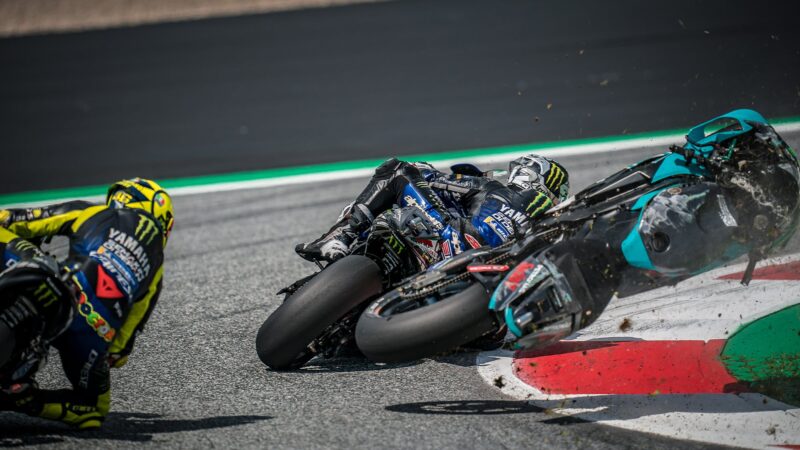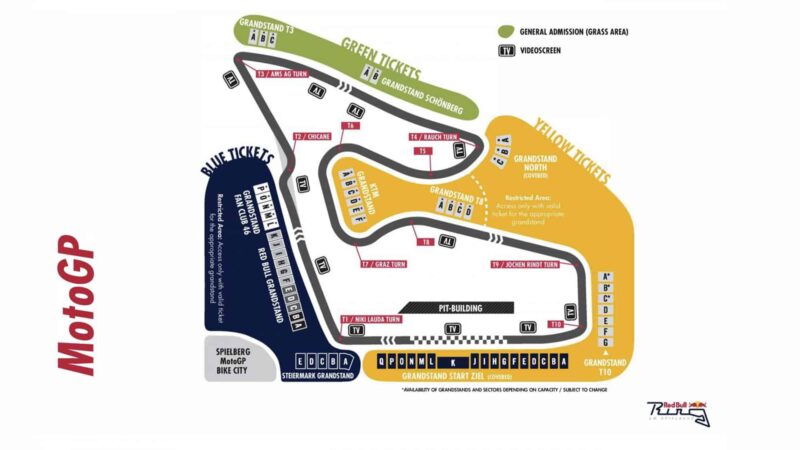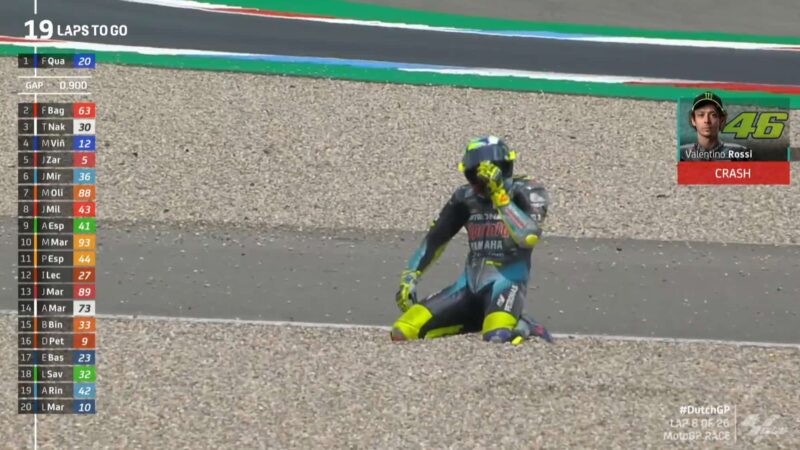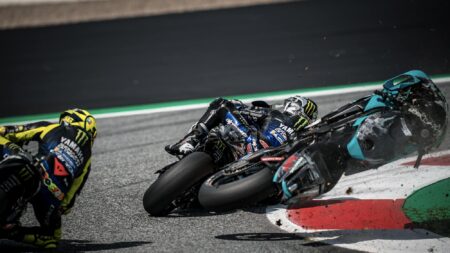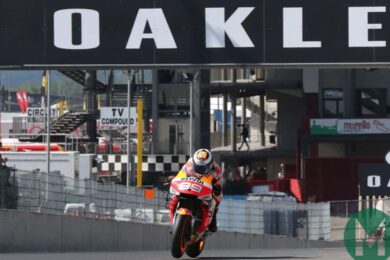Anywhere else?
“Turns 6 and 7 at Assen and the very fast left [Turn 15, Ramshoek]. They are all quite dangerous because you are very fast in these corners.”
It is perhaps significant that Rossi chooses Assen’s Turn 7 left-hander, because he had a nasty fall there during this year’s Dutch TT. His immediate reaction – sat slumped in the gravel – seemed to say a lot. Was this the moment when he finally decided: ‘I’ve had enough of this’? After all, that’s what Jorge Lorenzo decided after he crashed there in 2019, breaking a vertebra.
Marc Márquez
Márquez knows a lot about circuit safety, because he has tested it on many occasions.
Once again I asked the question while we were at Red Bull Ring in August.
“Here there are Turns 2 and 3, and also Turn 1, which is safe, but many times we see that when riders crash on the exit they stay in the middle of the track, so we need to understand this and improve the safety,” he said.
“I cannot think of all the circuits now, but, for example, every time we go to Jerez the walls are too close and we hit the airfence when we crash: at the corner where I crashed last year [Turn 3] and also Turn 7 [the fast left after the hairpin at the end of the back straight] and Turn 10 [the medium-speed right before the high-speed double right that precedes the final corner].”
I asked Márquez what he thinks about the exit of Portimao’s Turn 8. This is the right-hander followed by a steep and totally blind brow, where Moto2 rider Aron Canet crashed at last year’s Portuguese GP. Canet lost it before cresting the brow, sliding down the hill, completely unsighted by riders behind him. He was on the ground, bikes racing past on either side at over 100mph. Very scary.
“Yes, that’s dangerous, but it’s inside the red point, inside the limit,” added Márquez. “Of course a flat circuit is safer, but Portimao is nicer to ride! In the end the most important thing is runoff areas.”
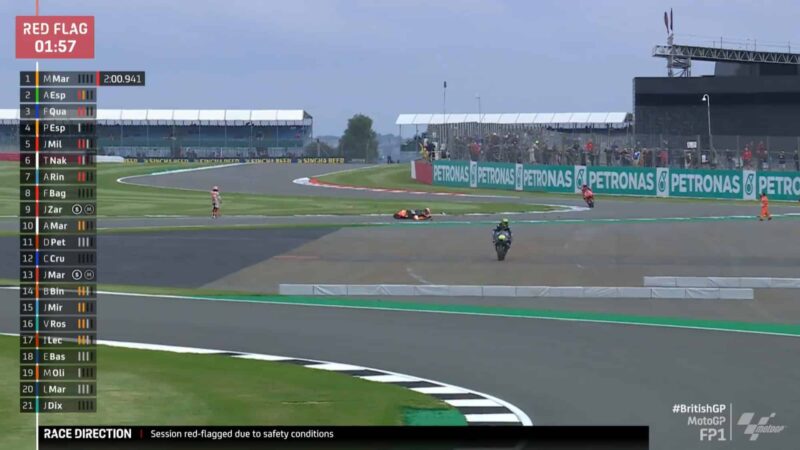
Márquez after his Turn 2 crash at Silverstone, which had rider and bike come to rest on the track at Turn 3
Dorna Sports, S.L.
Fabio Quartararo
This year MotoGP went to Silverstone after two races at Red Bull Ring. On Friday Márquez had a huge crash entering Silverstone’s high-speed Turn 2, which had the six-time MotoGP king and his bike end back up on the track at Turn 3.
Cal Crutchlow had the same crash some years ago and most significantly Loris Baz and Pol Espargaró fell there on the first lap of the 2016 MotoGP race. Both bikes and riders came back onto the track, missing others by a metre or two.
No wonder this corner sequence was on Quartararo’s mind when I spoke to him during British GP practice.
“Where Marc crashed today is really fast,” he said. “It’s bad when you crash there alone, but when you’re in a group it’s really dangerous.
“I need to think more deeply about other corners. but I don’t think there are many tracks where we need to do something.”
Quartararo’s final words are the words of a youngster – ask him the same question in five or ten years and he will most likely have more to say about circuit safety!
Danilo Petrucci
Petrucci came very close to being involved in the fiery Dani Pedrosa/Lorenzo Savadori crash during August’s Styrian GP, when Pedrosa crashed exiting the Turn 3 hairpin and Savadori hit his bike. His description of the incident is worth listening to.
“Turns 2 and 3 here are the most dangerous in MotoGP,” he said during practice for the following weekend’s Austrian GP. “You arrive in sixth gear and you’re braking while leaning, then the corner is really tight and when you are in the middle of the corner you can’t see the exit because it’s uphill.
“I saw him hit the back of his head really, really hard, and then the bike exploded in flames.”
“I was next to Savadori when he hit Pedrosa’s bike. I was trying to pass him on the inside and when we opened the throttle we found Pedrosa’s bike in our way. I saw Lorenzo hit the bike and I also saw him hit the back of his head really, really hard, and then the bike exploded in flames.”
Another corner that concerns Petrucci is Turn 1 at Phillip Island.
“That’s quite a scary corner – when you go into Turn 1 it’s always difficult because you go in there at 330kmh [205mph] and it’s always cold and always windy.
“Of course it’s our job to do this but reducing the risk at places like Turn 3 at Red Bull Ring is good because there are many risky corners in MotoGP, but not like that. No one likes that kind of corner, whereas most riders love Phillip Island.”
Catalunya 2019: Dovizioso and Viñales get skittled by Lorenzo
Aleix Espargaró
When Valentino Rossi retires Aleix Espargaró will be the second most experienced rider in MotoGP after Andrea Dovizioso. And the Aprilia rider is never afraid to speak his mind, especially on safety.
Thankfully his least favourite corner after Red Bull Ring’s Turns 2 and 3 has already been fixed. Catalunya’s Turn 10 was widened for 2021 several years after it had been tightened into a very slow hairpin. Slow corners are supposed to be safer, but they’re not if they’re very slow and have riders braking into them from very high speed, because the likelihood of multiple rider crashes increases.
